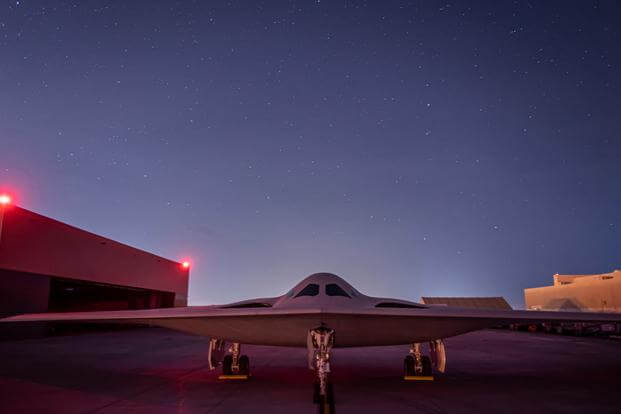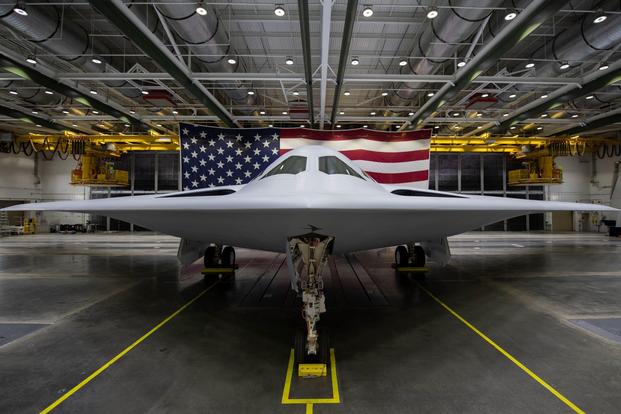The Air Force’s highly classified B-21 Raider was revealed in Palmdale, California, on Friday evening, marking the Pentagon’s first new American bomber in more than 30 years and the latest upgrade to the U.S. military’s nuclear triad amid rising tensions with China.
Stage hands at Northrop Grumman’s facility pulled a massive sheet draped over the aircraft revealing the muted white, long, narrow and sleek B-21 beneath it. The new aircraft is a significant update to the Pentagon’s nuclear arsenal – the triad of land, sea and air weapons that can deliver a nuclear payload. Prior to Friday’s ceremony, the public had only seen artist renderings of the aircraft.
“The B-21 looks imposing, but what's under the frame and the space-age coating is even more impressive,” said Secretary of Defense Lloyd J. Austin III. “This isn't just another airplane. It’s not just another acquisition. It is a symbol and a source of the fighting spirit that President [Ronald] Reagan spoke of. It is the embodiment of America's determination to defend the Republic that we all love.”
Read Next: 100-Year-Old Flying Ace is Promoted to Honorary Brigadier General by Air Force Chief
The Northrop Grumman-developed B-21 is capable of carrying conventional bombs and missiles as well as nuclear munitions. The defense manufacturer was awarded the contract for the aircraft in 2015.
Northrop Grumman also makes the B-2, the last generation of bomber that bears more than a passing resemblance to the B-21. That aircraft, which first flew in the 1980s, has been a backbone U.S. projection for decades. It was one of the first major aircraft designed as a “flying wing” that didn’t have a tail, an approach that gained prominence during World War II with aircraft developed for Germany by the Horton brothers.
The B-21 was named for the U.S. Army Air Force’s Doolittle Raiders, whose surprise attack against Japan during World War II boosted American morale. Austin said during his speech that there were family members of the Doolittle Raiders present in the audience.
“The audacity of the Doolittle Raiders has inspired generations of American airmen and it's fitting that the next chapter in American air power is named in their honor,” Austin said.
Many of the details, such as the size, payload and technology, of the aircraft have not been made public.
But the B-21 – according to an Air Force fact sheet – was “designed to accommodate manned or unmanned operations,” a reflection of the increasing reliance on unmanned aircraft by the U.S. military and the future of the pilot speciality.
The service has not fully delivered on, or explained what, that unmanned concept or capability would look like. Defense experts told Military.com prior to the rollout that it is unlikely we’d see a fully autonomous bomber anywhere in the near future.
“There will always be the need to have a human to occupy an aircraft for a variety of reasons,” Dave Deptula, a retired Air Force lieutenant general and dean of the nonprofit Mitchell Institute for Aerospace Studies, told Military.com on Friday. “And there’s enormous potential for unmanned aircraft in the future, but we have yet to build one that provides the capability like the B-21 … Do you want to take a human out of an aircraft that has nuclear capabilities?”
In 2021, Air Force Secretary Frank Kendall publicly discussed the idea of having a drone counterpart to the B-21 that would essentially act as a wingman alongside the bomber. But Kendall later backtracked, telling Breaking Defense in July that the concept was not as “cost-effective” and “less attractive” than previously thought.

Mackenzie Eaglen, a researcher at the Washington-based American Enterprise Institute think tank who focuses on Air Force defense budgets and military readiness, told Military.com that the technology, as well as the public’s comfort with an unmanned aircraft such as a bomber, isn’t there just yet.
“As far as I know, there will always be a man in the loop or on the loop,” Eaglen said on Friday, referring to the idea that a human would be either in control of weapons use or able to stop a computer from firing. “But, increasingly, the machine will be making the calculations and decisions, but a human will be there to authorize it or possibly walk it back … I don’t see the technology there yet to take the pilot out of the equation.”
Austin mentioned during his speech that the B-21 was built to last and expressed optimism in its future with the U.S. military.
The Raider was built with an open system architecture which makes it easier to modify, also making it easier to integrate new weapons that haven't even been invented yet, Austin said. “And the B-21’s edge will last for decades to come.”
Because of the bomber’s role as part of the U.S. nuclear arsenal and the design elements that make it stealthy, the B-21 program has been shrouded in secrecy, with Friday’s ceremony a long-awaited glimpse of the aircraft.
Last year, the U.S. Air Force released a rendering of the B-21, showing the long-range stealth bomber taking off from Edwards Air Force Base, California, where it will someday be tested before taking on worldwide operations.
Following extensive environmental studies, in 2021, Ellsworth Air Force Base near Rapid City, South Dakota, was selected as the first installation to receive the aircraft. Sen. Mike Rounds, R-S.D., told Military.com in a statement that the reveal marks a great day for his state and the nation.
“This is the day we’ve been looking forward to,” Rounds told Military.com in a statement. “America gets to meet the most advanced weapon system ever developed by our country to defend ourselves and our allies. This is a really great day for Ellsworth Air Force Base, which will be the home of not only the training squadrons, but of the first operational squadron as well.”
The Pentagon plans to build 100 B-21s so far, six of which are in development. The average unit cost for each bomber is around $700 million, according to an Air Force fact sheet.
Historically aircraft purchasing estimates tend to be high, with tight budgets forcing the services to cut order expectations.
Budget documents show that producing the Raider program will cost around $20 billion through 2027. The B-21 bomber will be set for its first flight in 2023.
“The next time you’ll see this plane, it’ll be in the air,” Kathy Warden, chief executive officer and president of Northrop Grumman, told the crowd.
-- Thomas Novelly can be reached at thomas.novelly@military.com. Follow him on Twitter @TomNovelly.
Related: The New B-21 Stealth Bomber to Be Revealed Later This Year, Senator Says











